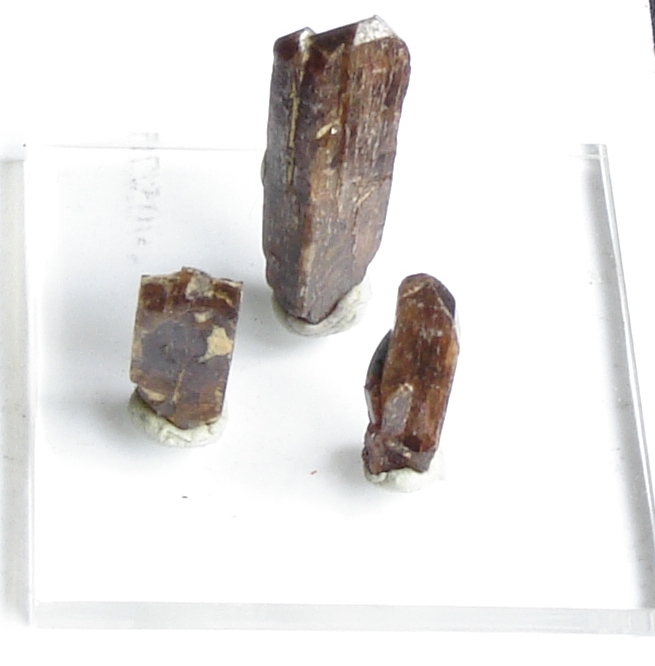- Xenotime
Infobox mineral
name = Xenotime
boxwidth =

caption = Xenotime from the Poços de Caldas alkaline massif,Brazil
formula = YPO4
color = Brown, brownish yellow, gray
habit = Prismatic, aggregate, granular
system =Tetragonal
cleavage = Perfect, two directions
fracture = Uneven to irregular
mohs = 4.5
luster = Vitreous to resinous
refractive = 1.720-1.815 (DR +0.095)
pleochroism = Dichroic
streak = White
gravity = 4.4–5.1
melt =
solubility =Xenotime (from the Greek words "xenos", "foreign", and "time", "honour") is a Rare Earth phosphate mineral, whose major component is yttrium orthophosphate (YPO4). It forms a solid solution series with
chernovite-(Y) (YAsO4) and therefore may contain trace impurities ofarsenic , as well assilicon dioxide andcalcium . The Rare Earthsdysprosium ,erbium ,terbium , andytterbium , and metal elements likethorium anduranium (all replacing yttrium) are the expressive secondary components of xenotime. Due to uranium and thorium impurities, some xenotime specimens may be weakly to stronglyradioactive .Lithiophyllite ,monazite , andpurpurite are sometimes grouped with xenotime in the informal "anhydrous phosphates" group. Xenotime is used chiefly as a source of yttrium and heavylanthanide metals (dysprosium, ytterbium, erbium, and gadolinium). Occasionally,gemstone s are also cut from the finer xenotime crystals.The
etymology of the name "xenotime" is uncertain: the mineral may be named so because it occurs in such small crystals that were once overlooked, or because the yttrium contained within it was first thought to be a new element. According to Vickery, the original name of the mineral was "kenotime", but due to a misprint, the "k" became an "x", and the change stuck.Properties
Crystallising in the
tetragonal (I41/amd)crystal system , xenotime is typically translucent to opaque (rarely transparent) in shades of brown to brownish yellow (most common), but also reddish to greenish brown and gray. Xenotime has a variable habit: It may be prismatic (stubby or slender and elongate) with dipyramidal terminations, in radial or granular aggregates, or rosettes. A soft mineral (Mohs hardness 4.5), xenotime is—in comparison to most other translucent minerals—fairly dense, with aspecific gravity between 4.4–5.1. Its lustre, which may be vitreous to resinous, together with its crystal system, may lead to a confusion withzircon (ZrSiO4), that a similar crystal structure and with which xenotime may sometimes occur.Xenotime has two directions of perfect prismatic cleavage and its
fracture is uneven to irregular (sometimes splintery). It is considered brittle and its streak is white. Therefractive index of xenotime is 1.720-1.815 with abirefringence of 0.095 (uniaxial positive). Xenotime is dichroic with pink, yellow, or yellowish brown seen in the extraordinary ray, and brownish yellow, grayish brown or greenish brown seen in the ordinary ray. There is no reaction underultraviolet light. While xenotime may contain significant amounts of thorium or uranium, the mineral does not undergometamictization likesphene or zircon would.Occurrence
Occurring as a minor accessory mineral, xenotime is found in
pegmatite s and otherigneous rock s, as well asgneiss es rich inmica andquartz . Associated minerals includebiotite and other micas,chlorite group minerals, quartz, zircon, certainfeldspar s,analcime ,anatase ,brookite ,rutile ,siderite , andapatite . Xenotime is also known to be diagenetic: It may form as minute grains or as extremely thin (less than 10 µ) coatings on detrital zircon grains in siliciclasticsedimentary rock s. The importance of these diagenetic xenotime deposits in theradiometric dating of sedimentary rocks is only beginning to be realised. [http://www.geoconferences.org/grant_reports/2002_GAC/vallini.html]Discovered in
1832 , xenotime's type locality isHidra (Hitterø),Flekkefjord ,Vest-Agder ,Norway . Other notable localities include:Arendal andTvedestrand , Norway;Novo Horizonte, São Paulo ,Novo Horizonte, Bahia , andMinas Gerais ,Brazil ;Madagascar ; andCalifornia ,Colorado , Georgia, andNorth Carolina ,United States . A new discovery of gemmy, colour change (brownish to yellow) xenotime has been reported fromAfghanistan . North ofMount Funabuse inGifu Prefecture ,Japan , a notablebasalt ic rock is quarried at a hill called Maru-Yama: Crystals of xenotime and zircon arranged in a radiating, flower-like pattern are visible in polished slices of the rock, which is known as "chrysanthemum stone" (translated from the Japanese "kiku-ishi"). This stone is widely appreciated in Japan for its ornamental value.Small tonnages of xenotime sand are recovered, in association with Malaysian tin mining, etc., and are processed commercially. The lanthanide content is typical of "yttrium earth" minerals, and runs about two-thirds yttrium, with the remainder being mostly the heavy lanthanides, where the even-numbered lanthanides (such as Gd, Dy, Er, or Yb) each being present at about the 5% level, and the odd-numbered lanthanides (such as Tb, Ho, Tm, Lu) each being present at about the 1% level. Dysprosium is usually the most abundant of the even numbered heavies, and holmium is the most abundant of the odd numbered heavies. The lightest lanthanides are generally better represented in xenotime than the heaviest lanthanides are in monazite.
See also
*
List of minerals
*Wakefieldite References
* [http://www.mindat.org/min-4333.html Mindat.org: Xenotime]
* [http://www.webmineral.com/data/Xenotime-%28Y%29.shtml Webmineral.com: Xenotime]
*Webster, R. (2000). "Gems: Their sources, descriptions and identification" (5th ed.), p. 182. Butterworth-Heinemann, Great Britain. ISBN
Wikimedia Foundation. 2010.
